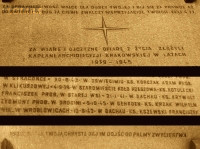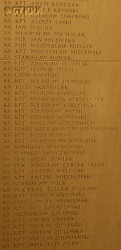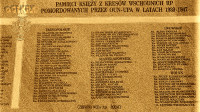Roman Catholic
St Sigismund parish
05-507 Słomczyn
85 Wiślana Str.
Konstancin deanery
Warsaw archdiocese, Poland
full list:
displayClick to display full list

searchClick to search full list by categories
wyświetlKliknij by wyświetlić pełną listę po polsku

szukajKliknij by przeszukać listę wg kategorii po polsku

Martyrology of the clergy — Poland
XX century (1914 – 1989)
personal data

surname
KORCZAK
forename(s)
Adam Steven (pl. Adam Stefan)
function
diocesan priest
creed
Latin (Roman Catholic) Church RCmore on
en.wikipedia.org
[access: 2014.09.21]
diocese / province
Cracow archdiocesemore on
en.wikipedia.org
[access: 2013.05.19]
RC Military Ordinariate of Polandmore on
en.wikipedia.org
[access: 2014.12.20]
date and place
of death
04.09.1939

Miłocintoday: district of Rzeszów, Rzeszów city pov., Subcarpathia voiv., Poland
more on
en.wikipedia.org
[access: 2021.06.07]
alt. dates and places
of death
09.1939
Staromieścietoday: district of Rzeszów, Rzeszów city pov., Subcarpathia voiv., Poland
more on
en.wikipedia.org
[access: 2021.06.07]
Przemyśltoday: Przemyśl city pov., Subcarpathia voiv., Poland
more on
en.wikipedia.org
[access: 2021.04.01]
Lvivtoday: Lviv urban hrom., Lviv rai., Lviv obl., Ukraine
more on
en.wikipedia.org
[access: 2022.01.16]
details of death
In 1927 and 1929 appointed reserve chaplain of the Polish Army (each time for a statutory 2‐year period).
In 08.1939 (or in the first days of 09.1939) mobilized.
After the German invasion of the Republic of Poland on 01.09.1939 (the Russians attacked Poland 17 days later) and the start of World War II, went to Kraków, and from there traveled by train from Kraków to Rzeszów, towards the place of mobilization.
There are discrepancies as to the exact place of mobilization: according to some sources, it was to be the 10th District Hospital under the Command of the Corps District DOK No. X in Przemyśl; according to others, the barracks of the garrison of the 5th Infantry Division under the Command of the Corps District DOK No. VI in Lviv.
Did not reach the mobilization site. Perished during aerial genocidal bombardment of the train by German bombers, together with a few passengers (among the wounded was a well–known Polish politician, former Polish Prime Minister, Vincent Witos).
alt. details of death
According to other sources reached the mobilization site, but was murdered by an Ukrainian band rampant after war outbreak.
cause of death
shelling (bombardment)
perpetrators
Germans
sites and events
Air raids 1939Click to display the description, Ribbentrop‐MolotovClick to display the description, Pius XI's encyclicalsClick to display the description
date and place
of birth
20.12.1895

Krakówtoday: Kraków city pov., Lesser Poland voiv., Poland
more on
en.wikipedia.org
[access: 2021.06.07]
parents
KORCZAK Martin
🞲 ?, ? — 🕆 ?, ?

Francesca
🞲 ?, ? — 🕆 ?, ?
presbyter (holy orders)
ordination
16.06.1918

Krakówtoday: Kraków city pov., Lesser Poland voiv., Poland
more on
en.wikipedia.org
[access: 2021.06.07]
St Stanislav the Bishop and Martyr and St St WenCeslav the Martyr RC cathedral churchmore on
en.wikipedia.org
[access: 2017.11.07] (basillica „on Wawel Hill”)
positions held
1931 – 1939
curatus/rector/expositus — Klikuszowatoday: Nowy Targ gm., Nowy Targ pov., Lesser Poland voiv., Poland
more on
en.wikipedia.org
[access: 2022.07.19] ⋄ St Martin the Bishop RC church ⋄ Nowy Targtoday: Nowy Targ gm., Nowy Targ pov., Lesser Poland voiv., Poland
more on
en.wikipedia.org
[access: 2021.06.07], St Catherine the Virgin and Martyr RC parish ⋄ Nowy Targtoday: Nowy Targ gm., Nowy Targ pov., Lesser Poland voiv., Poland
more on
en.wikipedia.org
[access: 2021.06.07] RC deanery
1928 – 1931
vicar — Rabkatoday: Rabka‐Zdrój, Rabka‐Zdrój gm., Nowy Targ pov., Lesser Poland voiv., Poland
more on
en.wikipedia.org
[access: 2021.06.07] ⋄ St Mary Magdalene RC parish ⋄ Maków Podhalańskitoday: Maków Podhalański gm., Sucha Beskidzka pov., Lesser Poland voiv., Poland
more on
en.wikipedia.org
[access: 2021.06.07] RC deanery
1926 – 1927
vicar — Morawicatoday: Liszki gm., Kraków pov., Lesser Poland voiv., Poland
more on
en.wikipedia.org
[access: 2021.12.18] ⋄ St Bartholomew the Apostle RC parish ⋄ Czernichówtoday: Czernichów gm., Kraków pov., Lesser Poland voiv., Poland
more on
en.wikipedia.org
[access: 2021.06.07] RC deanery
1925 – 1926
vicar — Oświęcimtoday: Oświęcim gm., Oświęcim pov., Lesser Poland voiv., Poland
more on
en.wikipedia.org
[access: 2021.06.07] ⋄ Assumption of the Blessed Virgin Mary RC parish ⋄ Oświęcimtoday: Oświęcim gm., Oświęcim pov., Lesser Poland voiv., Poland
more on
en.wikipedia.org
[access: 2021.06.07] RC deanery
1924 – 1925
vicar — Maniowytoday: Czorsztyn gm., Nowy Targ pov., Lesser Poland voiv., Poland
more on
en.wikipedia.org
[access: 2021.06.07] ⋄ St Nicholas the Bishop RC parish ⋄ Nowy Targtoday: Nowy Targ gm., Nowy Targ pov., Lesser Poland voiv., Poland
more on
en.wikipedia.org
[access: 2021.06.07] RC deanery
1923 – 1924
vicar — Jeleśniatoday: Jeleśnia gm., Żywiec pov., Silesia voiv., Poland
more on
en.wikipedia.org
[access: 2021.12.18] ⋄ St Adalbert the Bishop and Martyr RC parish ⋄ Żywiectoday: Żywiec urban gm., Żywiec pov., Silesia voiv., Poland
more on
en.wikipedia.org
[access: 2021.06.07] RC deanery
1921 – 1923
vicar — Rybnatoday: Czernichów gm., Kraków pov., Lesser Poland voiv., Poland
more on
en.wikipedia.org
[access: 2021.06.07] ⋄ St Casimir RC parish ⋄ Czernichówtoday: Czernichów gm., Kraków pov., Lesser Poland voiv., Poland
more on
en.wikipedia.org
[access: 2021.06.07] RC deanery
1918 – 1921
vicar — Sułkowicetoday: Sułkowice gm., Myślenice pov., Lesser Poland voiv., Poland
more on
en.wikipedia.org
[access: 2021.06.07] ⋄ All the Saints RC parish ⋄ Lanckoronatoday: Lanckorona gm., Wadowice pov., Lesser Poland voiv., Poland
more on
en.wikipedia.org
[access: 2021.06.07] RC deanery
1914 – 1918
student — Krakówtoday: Kraków city pov., Lesser Poland voiv., Poland
more on
en.wikipedia.org
[access: 2021.06.07] ⋄ philosophy and theology, Department of Theology, Jagiellonian University UJ
1914 – 1918
student — Krakówtoday: Kraków city pov., Lesser Poland voiv., Poland
more on
en.wikipedia.org
[access: 2021.06.07] ⋄ philosophy and theology, Theological Seminary ⋄ Kraków RC archdiocese
sites and events
descriptions
Air raids 1939: During invasion of Poland commenced on 01.09.1939 Germans systematically attacked civilian targets. Many cities (Wieluń, Frampol, Warszawa, Lwów, Łomża, Puck, etc.) were bombed during air raids and totally destroyed. The hospitals and churches, visibly marked as such, were not spared. German planes also attacked columns of fleeing people on the roads, massacring them. It is estimated that c. 150,000‐200,000 civilians were killed or murdered by the Germans in 09.1939. (more on: en.wikipedia.orgClick to attempt to display webpage
[access: 2015.04.18])
Ribbentrop‐Molotov: Genocidal Russian‐German alliance pact between Russian leader Joseph Stalin and German leader Adolf Hitler signed on 23.08.1939 in Moscow by respective foreign ministers, Mr. Vyacheslav Molotov for Russia and Joachim von Ribbentrop for Germany. The pact sanctioned and was the direct cause of joint Russian and German invasion of Poland and the outbreak of the World War II in 09.1939. In a political sense, the pact was an attempt to restore the status quo ante before 1914, with one exception, namely the „commercial” exchange of the so‐called „Kingdom of Poland”, which in 1914 was part of the Russian Empire, fore Eastern Galicia (today's western Ukraine), in 1914 belonging to the Austro‐Hungarian Empire. Galicia, including Lviv, was to be taken over by the Russians, the „Kingdom of Poland” — under the name of the General Governorate — Germany. The resultant „war was one of the greatest calamities and dramas of humanity in history, for two atheistic and anti‐Christian ideologies — national and international socialism — rejected God and His fifth Decalogue commandment: Thou shall not kill!” (Abp Stanislav Gądecki, 01.09.2019). The decisions taken — backed up by the betrayal of the formal allies of Poland, France and Germany, which on 12.09.1939, at a joint conference in Abbeville, decided not to provide aid to attacked Poland and not to take military action against Germany (a clear breach of treaty obligations with Poland) — were on 28.09.1939 slightly altered and made more precise when a treaty on „German‐Russian boundaries and friendship” was agreed by the same murderous signatories. One of its findings was establishment of spheres of influence in Central and Eastern Europe and in consequence IV partition of Poland. In one of its secret annexes agreed, that: „the Signatories will not tolerate on its respective territories any Polish propaganda that affects the territory of the other Side. On their respective territories they will suppress all such propaganda and inform each other of the measures taken to accomplish it”. The agreements resulted in a series of meeting between two genocidal organization representing both sides — German Gestapo and Russian NKVD when coordination of efforts to exterminate Polish intelligentsia and Polish leading classes (in Germany called «Intelligenzaktion», in Russia took the form of Katyń massacres) where discussed. Resulted in deaths of hundreds of thousands of Polish intelligentsia, including thousands of priests presented here, and tens of millions of ordinary people,. The results of this Russian‐German pact lasted till 1989 and are still in evidence even today. (more on: en.wikipedia.orgClick to attempt to display webpage
[access: 2015.09.30])
Pius XI's encyclicals: Facing the creation of two totalitarian systems in Europe, which seemed to compete with each other, though there were more similarities than contradictions between them, Pope Pius XI issued in 03.1937 (within 5 days) two encyclicals. In the „Mit brennender Sorge” (Eng. „With Burning Concern”) published on 14.03.1938, condemned the national socialism prevailing in Germany. The Pope wrote: „Whoever, following the old Germanic‐pre‐Christian beliefs, puts various impersonal fate in the place of a personal God, denies the wisdom of God and Providence […], whoever exalts earthly values: race or nation, or state, or state system, representatives of state power or other fundamental values of human society, […] and makes them the highest standard of all values, including religious ones, and idolizes them, this one […] is far from true faith in God and from a worldview corresponding to such faith”. On 19.03.1937, published „Divini Redemptoris” (Eng. „Divine Redeemer”), in which criticized Russian communism, dialectical materialism and the class struggle theory. The Pope wrote: „Communism deprives man of freedom, and therefore the spiritual basis of all life norms. It deprives the human person of all his dignity and any moral support with which he could resist the onslaught of blind passions […] This is the new gospel that Bolshevik and godless communism preaches as a message of salvation and redemption of humanity”… Pius XI demanded that the established human law be subjected to the natural law of God , recommended the implementation of the ideal of a Christian state and society, and called on Catholics to resist. Two years later, National Socialist Germany and Communist Russia came together and started World War II. (more on: www.vatican.vaClick to attempt to display webpage
[access: 2023.05.28], www.vatican.vaClick to attempt to display webpage
[access: 2023.05.28])
sources
personal:
www.bj.uj.edu.plClick to attempt to display webpage
[access: 2012.11.23], www.kresykedzierzynkozle.home.plClick to attempt to display webpage
[access: 2013.01.13], wczorajidzis.rzeszow.plClick to attempt to display webpage
[access: 2017.03.24]
bibliographical:
„Register of Latin rite Lviv metropolis clergy’s losses in 1939‐45”, Józef Krętosz, Maria Pawłowiczowa, editors, Opole, 2005
„Biographical lexicon of Lviv Roman Catholic Metropoly clergy victims of the II World War 1939‐1945”, Mary Pawłowiczowa (ed.), Fr Joseph Krętosz (ed.), Holy Cross Publishing, Opole, 2007
„Mysterium iniquitatis. Clergy and religious of the Latin rite murdered by Ukrainian nationalists in 1939‐1945”, Fr Józef Marecki, Institute of National Remembrance IPN, Kraków 2020
original images:
wegliniec.plClick to attempt to display webpage
[access: 2014.10.31]
LETTER to CUSTODIAN/ADMINISTRATOR
If you have an Email client on your communicator/computer — such as Mozilla Thunderbird, Windows Mail or Microsoft Outlook, described at WikipediaPatrz:
en.wikipedia.org, among others — try the link below, please:
LETTER to CUSTODIAN/ADMINISTRATORClick and try to call your own Email client
If however you do not run such a client or the above link is not active please send an email to the Custodian/Administrator using your account — in your customary email/correspondence engine — at the following address:

giving the following as the subject:
MARTYROLOGY: KORCZAK Adam Steven
To return to the biography press below:
 Click to return to biography
Click to return to biography











